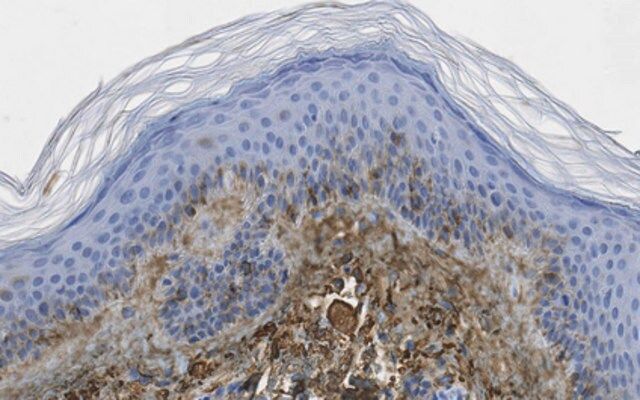您的位置:首页 > 产品中心 > Anti-Glycosaminoglycan Antibody, skin specific Antibody, clone PG-4
Anti-Glycosaminoglycan Antibody, skin specific Antibody, clone PG-4

产品别名
Anti-Glycosaminoglycan Antibody, skin specific Antibody, clone PG-4
Proteoglycan, Dermatan sulfate, Chondroitin sulfate
基本信息
| eCl@ss | 32160702 |
| NACRES | NA.41 |
| General description【一般描述】 | Proteoglycans (PG), present in all tissues, are one of the best-studied classes of matrix molecules. Over 50 members of PG have been characterized and studied for their biological significance. PG consist of a protein core to which glycosaminoglycan chains are covalently linked. Glycosaminoglycans (GAGs) are natural heteropolysaccharides that are present in every mammalian tissue. They are composed of repeating disaccharide units that consist of either sulfated or non-sulfated monosaccharides. Their molecular size and the sulfation type vary based on tissue type. The major types of GAGs found in mammalian tissues are: hyaluronan, chondroitin sulfate, and dermatan sulfate, heparin and heparan sulfate, and keratan sulfate. GAG chains are covalently bound to serine residues of the PG protein core via a tetrasaccharide linkage, consisting of xylose, two galactose residues and glucuronic acid. This antibody, clone PG-4, recognizes antigen that is associated with extracellular matrices and surfaces of cultured human dermal fibroblasts and the surfaces of cultured human adult keratinocytes. This antibody recognize native epitopes located within glycosaminoglycan chains and is detects both chondroitin sulfate (Versican) and dermatan sulfate (Decorin and Biglycan) proteoglycans. Treatment of PG with chondroitinases is reported to abolish its immunoreactivity for all antigens. (Ref.: Afratis, N et al. (2012). FEBS Journal 279 (7); 1177-1197; Sorrell, JM et al. (1999). Histochem. J. 31 (8); 549-558). |
| Specificity【特异性】 | Clone PG4 detects glycosaminoglycan in skin cells. |
| Immunogen【免疫原】 | Crude membrane fractions from adult human dermal fibroblasts from breast skin. |
| Application【应用】 | Research Category Cell Structure Western Blotting Analysis: A representative lot detected Glycosaminoglycan in Western Blotting applications (Sorrell, J.M., et. al. (1999). Histochem J. 31(8):549-58). ELISA Analysis: A representative lot detected Glycosaminoglycan in ELISA applications (Sorrell, J.M., et. al. (1999). Histochem J. 31(8):549-58). Immunohistochemistry Analysis: A representative lot detected Glycosaminoglycan in Immunohistochemistry applications (Sorrell, J.M., et. al. (1999). Histochem J. 31(8):549-58). Anti-Glycosaminoglycan, skin specific, clone PG-4, Cat. No. MABT819, is a mouse monoclonal antibody that detects glycosaminoglycan and has been tested for use in ELISA, Immunohistochemistry (Paraffin), and Western Blotting. |
| Quality【质量】 | Evaluated by Immunohistochemistry (Paraffin) in human skin tissue. Immunohistochemistry Analysis: A 1:250 dilution of this antibody detected Glycosaminoglycan in human skin tissue. |
| Physical form【外形】 | Protein G purified Purified mouse monoclonal antibody IgM in buffer containing 0.1 M Tris-Glycine (pH 7.4), 150 mM NaCl with 0.05% sodium azide. Format: Purified |
| Other Notes【其他说明】 | Concentration: Please refer to lot specific datasheet. |
产品性质
| Quality Level【质量水平】 | 100 |
| biological source【生物来源】 | mouse |
| antibody form【抗体形式】 | purified immunoglobulin |
| antibody product type | primary antibodies |
| clone【克隆】 | PG-4, monoclonal |
| species reactivity | shark, human, chicken |
| packaging【包装】 | antibody small pack of 25 μL |
| technique(s) | ELISA: suitable immunohistochemistry: suitable (paraffin) western blot: suitable |
| isotype【同位素/亚型】 | IgMκ |
| shipped in【运输】 | ambient |
产品说明
| Target description【目标描述】 | ~60 kDa observed. Uncharacterized bands may be observed in some lysate(s). |
| Storage and Stability【储存及稳定性】 | Stable for 1 year at 2-8°C from date of receipt. |
| Disclaimer【免责声明】 | Unless otherwise stated in our catalog or other company documentation accompanying the product(s), our products are intended for research use only and are not to be used for any other purpose, which includes but is not limited to, unauthorized commercial uses, in vitro diagnostic uses, ex vivo or in vivo therapeutic uses or any type of consumption or application to humans or animals. |




